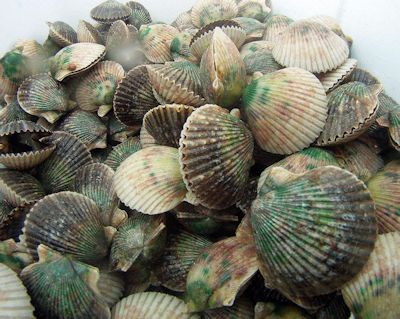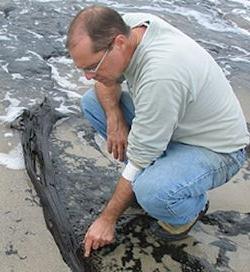Reprinted from the Tideland News
A long, long wait is nearly over: Bay scallop season will open later this month in Bogue Sound and waters south for the first time since 2005, so one of the state’s most delectable seafood products will again be available.
But while a harvest is certainly good news and might be in part the result of improvements in water quality and sea grass beds, all is still not well for the tasty bivalve.
Supporter Spotlight
Tina Moore, the lead scallop biologist for the N.C. Division of Marine Fisheries, said Friday that the Jan. 28 opening was triggered by the current bay scallop management plan, which mandates an opening if sampling shows the population has met predetermined levels.
 North Carolina once led the nation in bay scallop harvests. Photo: N.C. Division of Marine Fisheries North Carolina once led the nation in bay scallop harvests. Photo: N.C. Division of Marine Fisheries |
The plan, adopted in 2007, sets specific harvest levels if the scallop sampling reaches 50 percent, 75 percent or 125 percent of the level found in sampling in 1984 and 1985, two good bay scallop harvest years before the 1987 red tide thought to have been the be-ginning of the population’s dramatic demise.
This year, Moore said, sampling in western Bogue Sound in October hit 50.01 percent, barely above the minimum threshold, but enough to mandate an opening. And, because the management plan requires that all internal waters south of Bogue Sound to the South Carolina line open to bay scallop harvesting if Bogue Sound opens, those waters will open Jan. 28, as well.
Fishermen, however, should not get too excited about that news, because while there are definitely some bay scallops in the traditional harvest areas of Bogue Sound, division sampling did not find any bay scallops in those more southerly waters, such as the New River and Topsail areas. Nor did sampling in the traditional bay scallop areas of Down East Carteret County – Back Sound, for example – meet the minimum threshold, so those waters won’t open.
“Bay scallops are still considered a “species of concern’” in the fisheries division’s stock status hierarchy, Moore said, and the fact that sampling met only the bare minimum for an opening means the harvest limit will be very strict.
Supporter Spotlight
Commercial harvest will be allowed from 7:30 a.m. to 4 p.m. Monday and Wednesday of each week. Commercial fishermen may harvest 10 bushels a person a day, not to exceed 20 bushels a vessel, regardless of the number of licensed fishermen working together on a boat.
Recreational harvest will be allowed from 7:30 a.m. to 4 p.m. Thursday, Friday, Saturday and Sunday of each week. Recreational fishermen may harvest a limit of one bushel per person per day, not to exceed one bushel if two or more fishermen are working from one vessel.
Recreational harvest limits cannot be combined with commercial harvest limits.
Scallops may be taken by hand, with hand rakes, hand tongs, dip nets and scoops. Dredging will not be allowed.
By law, under the management plan, the season will remain open until April 1.
 Scallop researcher Stephen Fegley can’t pinpoint the cause of the improved bay scallop population. Photo: UNC Scallop researcher Stephen Fegley can’t pinpoint the cause of the improved bay scallop population. Photo: UNC |
The minimal numbers found in the sampling, and the low harvest limits, mean that nobody “is going to get rich” on the harvest this year, according to Stephen Fegley, an associate professor and researcher at the UNC Institute of Marine Sciences in Morehead City. Fegley and another professor and researcher, Charles “Pete” Peterson, have for several years been studying ways to enhance the bay scallop population. Like Moore, he doesn’t think scallop populations are in great shape, even in the areas where enough have been found to mandate a season.
Fegley said sampling revealed no specific identifiable reasons for the population improve-ment, but there are a number of factors that likely helped some.
The biggest, of course, might simply be the lack of harvesting in the recent years. In addition, Moore said, the warm winter of 2011-12 might have helped.
Bay scallops have been enjoyed and harvested in North Carolina since before the state was settled by Europeans. Up until the red tide, in fact, the harvest, while small compared to many other species, was at least regionally important.
In 1928, the state led the nation in bay scallop production, with a harvest of 1.4 million pounds of meats. And as late as 1985, watermen hauled in 455,649 pounds of bay scallop meat, worth $1 million.
Then the red tide hit in 1987. The toxic algae, which arrived in the state via eddies off the Gulf Stream, lingered for months and decimated the stocks. That, combined with other factors, destroyed a fishery that had once provided pre-Christmas income in a short December season, as well as some good income in Carteret and other counties up into spring.
In 2004, the harvest hit a low of less than 150 pounds. Another scarce harvest in 2005 caused the fisheries division to close bay scallop fishing in 2006. As recommended by the 2007 Bay Scallop Fishery Management Plan, it remained closed for two years while biologists worked on setting a target index that would indicate that stocks were healthy enough to reopen fishing.
Other factors in the decline included the species’ reliance upon high-salinity beds of submerged aquatic vegetation, which are found only in certain estuarine areas. Scallop larvae attach to the vegetation then drop to the bottom once they reach about 1 inch. Aquatic vegetation, for a variety of reasons, including development and pollution, declined during a coastal building boom.
In addition, scallops live less than two years, and the population’s stocks are widely separated, meaning there is limited opportunity for one stock to help another recover from a demise. Researchers also believe the scallops were seriously affected by a big increase, beginning in the mid-1990s, of a natural predator, the cownose ray.
 Cownose rays are ferocious predators of bay scallops and may be one cause of the scallops demise. Photo: NOAA Cownose rays are ferocious predators of bay scallops and may be one cause of the scallops demise. Photo: NOAA |
Peterson had worked to enhance the bay scallop population after the red tide by trans-ferring some scallops from areas of relatively high numbers to traditionally good areas where the stock had been decimated. In the early- and mid-2000s, after hearing anecdotal reports from fishermen about the ray boom and predation of massive numbers of scallops, he began looking at that problem, too.
Eventually, Peterson and others at the institute, including Hal Summerson and Joel Fodrie, hit upon an idea to try to protect some bay scallops in “stockades,” made of PVC poles spaced about 10 inches apart and placed into scallop beds until rays have passed through.
That program has passed on to Fegley, who says it works, but has been woefully under-funded.
Fegley did set up two stockade sites in western Bogue Sound in 2010 and 2011. “It may have had some impact (on this year’s improvement) but there is really no way to know for sure,” he said.
Fegley and others are also studying if a little-known spring spawn of bay scallops – the main spawn is in fall – might be more significant than has been thought. Data from that study should be available soon, and could, if significant, play a role in future management.
The stockade strategy could be used to protect scallops during the fall spawning period, which coincides with the passage of the rays through local waters, Fegley said.
“In a time of severe state cutbacks, neither we nor the (fisheries) division have had the funding,” he said. “It might not sound like a lot of money, but you do have to pay people. Ultimately, what we might want to try is to work with some of the fishermen, locally, who could in a day or two help us set these up and see what impact it might have. The good thing is that when you do it, it doesn’t have any negative impact. The scallops do eventually move on.”
Other ideas from Peterson, Fegley and others at UNC include augmenting the stockades with spat collector bags to enhance the natural reproduction. The bags are made of transparent netting stuffed into a mesh bag that also contains Styrofoam as floats. The spat collector bags give juveniles additional places to settle and protect new recruits from predatory crabs and fish. Lab results have been good in ponds at the institute.
Meanwhile, division biologist Moore said, state officials are gearing up to update the 2007 management plan, as required by state fisheries law every five years. That process began last July, but will kick into high gear within about two weeks.
The management plan team should begin seeking public input this spring, and the general rule of thumb is that it takes about two years to develop and approve an updated plan. The goal is to have new rules, if needed, go into effect by April 2015.







